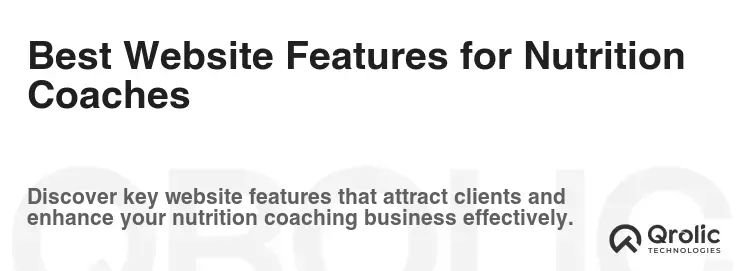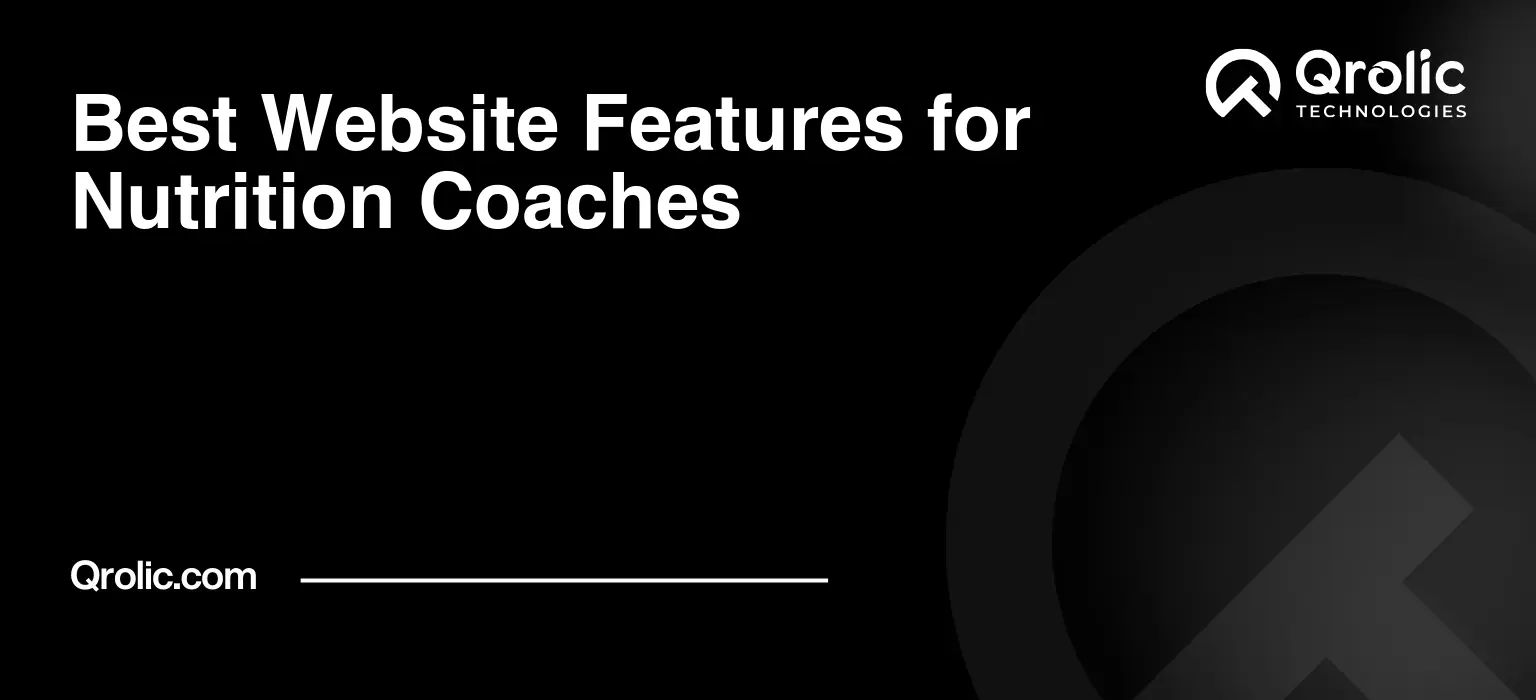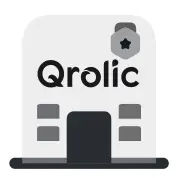Quick Summary:
- Create a strong, inviting website homepage.
- Offer easy online booking and payments.
- Showcase client success and expertise.
- Optimize for search engines to be found.
Table of Contents
- Best Website Features for Nutrition Coaches
- Why Your Nutrition Coaching Website Needs to Be More Than Just a Pretty Face
- Core Foundations: Essential Website Elements
- 1. Compelling Homepage: Your Digital First Impression
- 2. About Me: Building Trust and Connection
- 3. Contact Page: Making it Easy to Reach You
- 4. Blog: Establishing Authority and Providing Value
- Showcasing Your Expertise: Features to Highlight Your Services
- 5. Detailed Service Pages: Clearly Define Your Offerings
- 6. Client Success Stories & Testimonials: Building Credibility and Trust
- 7. Case Studies: Demonstrating Your Problem-Solving Abilities
- Streamlining the Client Experience: Features for Efficiency and Engagement
- 8. Online Session Booking: Convenience at Their Fingertips
- 9. Online Payment Integration: Seamless Transactions
- 10. Client Portal: A Central Hub for Resources and Communication
- 11. Downloadable Resources (Lead Magnets): Attracting and Engaging Potential Clients
- Advanced Features: Taking Your Website to the Next Level
- 12. Personalized Meal Planning Software: Tailored Nutrition Plans
- 13. Membership Programs: Creating Recurring Revenue and Building Community
- 14. Interactive Quizzes & Assessments: Engaging Your Audience and Gathering Data
- SEO Optimization: Making Your Website Discoverable
- 15. Keyword Research: Understanding What Your Audience is Searching For
- 16. On-Page Optimization: Making Your Website Search Engine Friendly
- 17. Off-Page Optimization: Building Authority and Credibility
- The Role of Qrolic Technologies
- Measuring Your Success: Tracking and Analyzing Your Website Performance
- 18. Google Analytics: Understanding Your Website Traffic
- 19. Conversion Tracking: Measuring Your Results
- Continuous Improvement: Keeping Your Website Fresh and Relevant
- 20. Regularly Update Your Content: Keep it Fresh and Engaging
- 21. Stay Up-to-Date with the Latest Trends: Adapt and Evolve
Best Website Features for Nutrition Coaches

Why Your Nutrition Coaching Website Needs to Be More Than Just a Pretty Face
In today’s digital world, your website is often the first interaction potential clients have with your nutrition coaching business. It’s not just a digital brochure; it’s a powerful tool for attracting, engaging, and converting leads into loyal clients. To stand out in a crowded market and truly connect with your audience, your website needs to offer more than just basic information. It needs to provide a seamless, informative, and personalized experience that showcases your expertise and builds trust. Let’s explore the essential features that will transform your nutrition coaching website from a static page into a dynamic engine for growth.
Core Foundations: Essential Website Elements
Before we dive into specialized features, let’s ensure your website has the foundational elements that are crucial for any successful online presence.
1. Compelling Homepage: Your Digital First Impression
Why It Matters: Your homepage is your virtual storefront. It needs to grab attention instantly and clearly communicate your value proposition.
Key Elements:
- Clear and Concise Headline: Immediately explain what you do and who you help. Focus on the benefit, not just the service. Instead of “Nutrition Coaching,” try “Achieve Sustainable Weight Loss & a Healthier Relationship with Food.”
- High-Quality Visuals: Use professional photos of yourself (smiling and approachable!) and images related to healthy eating and lifestyle. Avoid generic stock photos.
- Strong Call to Action (CTA): Tell visitors what you want them to do next. Examples include “Book a Free Discovery Call,” “Download Our Free Guide,” or “Learn More About Our Programs.”
- Brief Overview of Your Services: Highlight your core offerings and the problems they solve.
- Social Proof: Include testimonials, client success stories, or any relevant certifications and accreditations.
- Easy Navigation: Ensure a clear and intuitive menu that allows visitors to easily find the information they need.
Example: A nutrition coach specializing in diabetes management might feature a headline like: “Control Your Blood Sugar & Live a Healthier Life with Personalized Nutrition Plans.” The accompanying image could show a vibrant, balanced meal. The CTA could be “Schedule Your Free Diabetes Management Consultation.”
2. About Me: Building Trust and Connection
Why It Matters: People connect with people, not faceless businesses. Sharing your story and expertise builds trust and allows potential clients to see you as a credible and relatable guide.
Key Elements:
- Your Story: Share your personal journey, what led you to become a nutrition coach, and your passion for helping others.
- Your Qualifications: Highlight your education, certifications, and experience.
- Your Philosophy: Explain your approach to nutrition coaching and what makes you different.
- Your Values: Share your core values and what you stand for as a coach.
- Professional Photo: A high-quality photo of you looking approachable and confident.
Example: A nutrition coach who overcame their own struggles with disordered eating could share their personal journey of recovery and how it inspired them to help others heal their relationship with food. This vulnerability and authenticity can be incredibly powerful.
3. Contact Page: Making it Easy to Reach You
Why It Matters: Don’t make it difficult for potential clients to get in touch. A clear and accessible contact page is essential for generating leads.
Key Elements:
- Contact Form: Allow visitors to easily submit their inquiries directly through your website.
- Email Address: Provide a professional email address (not a personal one).
- Phone Number: If you’re comfortable, include your phone number for direct communication.
- Social Media Links: Link to your active social media profiles.
- Location (If Applicable): If you have a physical office, include your address and a map.
- Hours of Operation (If Applicable): Clearly state your business hours.
Example: A contact page could include a simple form with fields for name, email, phone number, and a message box. Below the form, include your email address and a button linking to your scheduling calendar.
4. Blog: Establishing Authority and Providing Value
Why It Matters: A blog is a powerful tool for attracting organic traffic, establishing yourself as an expert, and providing valuable content to your audience.
Key Elements:
- High-Quality, Relevant Content: Focus on topics that are relevant to your target audience’s needs and interests.
- SEO Optimization: Optimize your blog posts for relevant keywords to improve search engine rankings.
- Engaging Writing Style: Use a clear, concise, and engaging writing style that resonates with your audience.
- Visuals: Include images, videos, and infographics to break up text and make your content more visually appealing.
- Call to Action: Include a call to action at the end of each blog post to encourage readers to take the next step.
Example: A nutrition coach specializing in sports nutrition could write blog posts on topics such as “Fueling Your Body for Peak Performance,” “The Best Supplements for Athletes,” and “Recovery Nutrition Strategies.”
Showcasing Your Expertise: Features to Highlight Your Services
Now, let’s move on to the features that are specifically designed to showcase your nutrition coaching services and attract the right clients.
5. Detailed Service Pages: Clearly Define Your Offerings
Why It Matters: Don’t just list your services; explain them in detail and highlight the benefits for your clients.
Key Elements:
- Clear and Concise Description: Explain what each service entails and what clients can expect.
- Target Audience: Specify who the service is designed for.
- Benefits: Highlight the specific benefits of each service.
- Pricing: Be transparent about your pricing.
- Testimonials: Include testimonials from clients who have used the service.
- Call to Action: Encourage visitors to book a consultation or learn more.
Example: For a “Weight Loss Coaching Program,” you could describe the program’s duration, frequency of sessions, included resources (meal plans, recipes, etc.), and the support you provide. Highlight the benefits, such as “Achieve sustainable weight loss without restrictive dieting” and “Develop a healthier relationship with food.” Display plan display with clear pricing.
6. Client Success Stories & Testimonials: Building Credibility and Trust
Why It Matters: Social proof is incredibly powerful. Testimonials and success stories demonstrate the effectiveness of your coaching and build trust with potential clients.
Key Elements:
- Genuine Testimonials: Use real testimonials from satisfied clients.
- Specific Results: Focus on specific results that clients have achieved.
- Before and After Photos (with permission): If appropriate, include before and after photos to visually demonstrate the transformation.
- Video Testimonials: Video testimonials are even more impactful than written testimonials.
- Client Profiles: Create short profiles of your clients, highlighting their challenges and successes.
Example: “Before working with [Nutrition Coach’s Name], I was constantly struggling with cravings and emotional eating. After just a few months, I’ve lost 20 pounds, feel more confident, and have a much healthier relationship with food.” – Sarah J.
7. Case Studies: Demonstrating Your Problem-Solving Abilities
Why It Matters: Case studies provide a more in-depth look at how you’ve helped clients overcome specific challenges.
Key Elements:
- Clear Problem Statement: Clearly define the client’s initial problem.
- Your Approach: Explain your approach to solving the problem.
- Specific Actions: Describe the specific actions you took to help the client.
- Measurable Results: Highlight the measurable results that the client achieved.
- Client Quote: Include a quote from the client about their experience.
Example: A case study could detail how you helped a client with Irritable Bowel Syndrome (IBS) identify trigger foods, implement a personalized dietary plan, and reduce their symptoms. Include specific details about the client’s initial symptoms, the dietary changes you recommended, and the improvement in their symptoms after implementing the plan.
Streamlining the Client Experience: Features for Efficiency and Engagement
These features are designed to make it easier for potential clients to book sessions, access resources, and engage with your coaching programs.
8. Online Session Booking: Convenience at Their Fingertips
Why It Matters: Make it incredibly easy for potential clients to schedule a consultation or coaching session. An integrated session booking system eliminates back-and-forth emails and streamlines the process.
Key Elements:
- User-Friendly Interface: Choose a booking system that is easy to use and navigate.
- Real-Time Availability: Show your real-time availability to avoid double-booking.
- Automated Reminders: Send automated email and SMS reminders to reduce no-shows.
- Payment Integration: Allow clients to pay for their sessions online.
- Integration with Your Calendar: Integrate with your Google Calendar or other calendar system.
- Customizable Booking Options: Allow clients to choose the type of session, duration, and location (in-person or virtual).
Popular Booking Platforms: Acuity Scheduling, Calendly, HoneyBook, and Practice Better.
9. Online Payment Integration: Seamless Transactions
Why It Matters: Accepting online payments makes it easy for clients to pay for your services and reduces administrative overhead.
Key Elements:
- Secure Payment Gateway: Choose a secure payment gateway that protects client data.
- Multiple Payment Options: Offer multiple payment options, such as credit cards, debit cards, and PayPal.
- Recurring Payments: Set up recurring payments for ongoing coaching programs.
- Automated Invoices: Generate and send automated invoices.
- Reporting: Track your payments and revenue.
Popular Payment Gateways: Stripe, PayPal, Square.
10. Client Portal: A Central Hub for Resources and Communication
Why It Matters: A client portal provides a secure and convenient way for clients to access resources, communicate with you, and track their progress.
Key Elements:
- Secure Login: Ensure that the portal is secure and requires a password to access.
- Document Sharing: Allow clients to upload and download documents, such as intake forms, meal plans, and progress trackers.
- Messaging System: Provide a secure messaging system for communicating with clients.
- Progress Tracking: Allow clients to track their progress, such as weight loss, measurements, and food intake.
- Resource Library: Create a library of helpful resources, such as recipes, articles, and videos.
- Appointment Scheduling: Integrate with your online booking system to allow clients to schedule appointments directly from the portal.
Platforms with Client Portal Features: Practice Better, Healthie, NutriAdmin.
11. Downloadable Resources (Lead Magnets): Attracting and Engaging Potential Clients
Why It Matters: Offering free downloadable resources, such as meal plans, recipe guides, or e-books, is a great way to attract leads, build your email list, and provide value to potential clients.
Key Elements:
- High-Quality Content: Create resources that are valuable and relevant to your target audience.
- Attractive Design: Design your resources to be visually appealing and easy to read.
- Lead Capture Form: Require visitors to provide their email address in order to download the resource.
- Automated Email Sequence: Set up an automated email sequence to nurture your leads and encourage them to become clients.
Examples:
- “7-Day Healthy Meal Plan for Weight Loss”
- “The Ultimate Guide to Gut Health”
- “10 Delicious and Easy Smoothie Recipes”
Advanced Features: Taking Your Website to the Next Level
These features are not essential, but they can help you differentiate your website and provide a more personalized and engaging experience for your clients.
12. Personalized Meal Planning Software: Tailored Nutrition Plans
Why It Matters: Personalized meal plans are a key component of many nutrition coaching programs. Using meal planning software can save you time and effort while providing your clients with customized plans that meet their specific needs.
Key Elements:
- Large Recipe Database: Choose software with a large and diverse recipe database.
- Nutrient Analysis: Ensure that the software provides accurate nutrient analysis.
- Customization Options: Allow you to customize meal plans based on client preferences, dietary restrictions, and health goals.
- Shopping List Generation: Generate automated shopping lists based on the meal plan.
- Integration with Your Client Portal: Integrate with your client portal for easy access.
Popular Meal Planning Software: That Clean Life, NutriAdmin, Meal Garden.
13. Membership Programs: Creating Recurring Revenue and Building Community
Why It Matters: Membership programs can provide a steady stream of recurring revenue and create a sense of community among your clients.
Key Elements:
- Clear Value Proposition: Clearly define the value of your membership program.
- Exclusive Content: Offer exclusive content, such as webinars, recipes, and articles.
- Community Forum: Create a community forum where members can connect with each other and ask questions.
- Tiered Pricing: Offer different membership levels with varying features and benefits.
- Automated Billing: Set up automated billing for recurring payments.
Examples:
- “Healthy Recipe of the Month Club”
- “Exclusive Access to Live Q&A Sessions with [Nutrition Coach’s Name]”
- “Online Support Group for Weight Loss”
14. Interactive Quizzes & Assessments: Engaging Your Audience and Gathering Data
Why It Matters: Interactive quizzes and assessments can be a fun and engaging way to attract leads, gather data about your audience, and personalize the user experience.
Key Elements:
- Relevant Questions: Ask questions that are relevant to your target audience’s needs and interests.
- Personalized Results: Provide personalized results based on the user’s answers.
- Call to Action: Include a call to action at the end of the quiz to encourage users to take the next step.
Examples:
- “What’s Your Ideal Diet Type?”
- “Are You at Risk for Nutrient Deficiencies?”
- “How Healthy Is Your Relationship with Food?”
SEO Optimization: Making Your Website Discoverable
No matter how beautiful and functional your website is, it won’t be effective if people can’t find it. That’s where SEO (Search Engine Optimization) comes in.
15. Keyword Research: Understanding What Your Audience is Searching For
Why It Matters: Identifying the keywords that your target audience is using to search for nutrition coaching services is the foundation of any successful SEO strategy.
How to Do It:
- Brainstorm: Start by brainstorming a list of keywords related to your niche. Think about the problems your clients are trying to solve and the solutions you offer.
- Use Keyword Research Tools: Use tools like Google Keyword Planner, Ahrefs, or SEMrush to identify high-volume, low-competition keywords.
- Analyze Competitor Websites: See what keywords your competitors are using.
Example Keywords: “nutrition coach [city]”, “weight loss coach online”, “diabetes nutrition counseling”, “healthy eating plan”, “meal prep recipes”. nutrition coach website, session booking, plan display
16. On-Page Optimization: Making Your Website Search Engine Friendly
Why It Matters: On-page optimization involves optimizing your website’s content and structure to improve its search engine rankings.
Key Elements:
- Keyword-Rich Titles and Meta Descriptions: Use your target keywords in your page titles and meta descriptions.
- Header Tags (H1, H2, H3): Use header tags to structure your content and highlight important keywords.
- Image Alt Text: Add descriptive alt text to your images using your target keywords.
- Internal Linking: Link to other relevant pages on your website.
- Mobile-Friendly Design: Ensure that your website is responsive and mobile-friendly.
- Fast Loading Speed: Optimize your website’s loading speed for a better user experience.
17. Off-Page Optimization: Building Authority and Credibility
Why It Matters: Off-page optimization involves building your website’s authority and credibility by getting links from other reputable websites.
Key Elements:
- Guest Blogging: Write guest posts for other websites in your niche.
- Link Building: Earn links from other websites by creating high-quality content.
- Social Media Marketing: Promote your website and content on social media.
- Online Directories: List your website in relevant online directories.
The Role of Qrolic Technologies
Qrolic Technologies (https://qrolic.com/) can be a valuable partner in building and optimizing your nutrition coaching website. They offer a range of services, including:
- Website Design and Development: Creating visually appealing and user-friendly websites tailored to your specific needs.
- SEO Optimization: Helping you improve your search engine rankings and attract more organic traffic.
- Content Marketing: Creating high-quality content that engages your audience and establishes you as an expert.
- Online Booking System Integration: Seamlessly integrating booking systems to streamline your scheduling process.
- Client Portal Development: Building secure and convenient client portals for enhanced communication and resource sharing.
- E-commerce Solutions: Setting up online stores to sell meal plans, ebooks, and other digital products.
By leveraging Qrolic Technologies’ expertise, you can focus on what you do best – providing exceptional nutrition coaching services – while they handle the technical aspects of building and managing your online presence.
Measuring Your Success: Tracking and Analyzing Your Website Performance
It’s essential to track and analyze your website’s performance to see what’s working and what’s not.
18. Google Analytics: Understanding Your Website Traffic
Why It Matters: Google Analytics provides valuable insights into your website traffic, including the number of visitors, their location, the pages they visit, and the keywords they use to find your website.
Key Metrics to Track:
- Website Traffic: The total number of visitors to your website.
- Bounce Rate: The percentage of visitors who leave your website after viewing only one page.
- Time on Site: The average amount of time visitors spend on your website.
- Conversion Rate: The percentage of visitors who complete a desired action, such as booking a consultation or downloading a resource.
19. Conversion Tracking: Measuring Your Results
Why It Matters: Conversion tracking allows you to measure the effectiveness of your marketing efforts and identify which strategies are driving the most leads and clients.
Key Conversions to Track:
- Contact Form Submissions
- Appointment Bookings
- Resource Downloads
- Sales of Products or Services
Continuous Improvement: Keeping Your Website Fresh and Relevant
Your website is not a “set it and forget it” project. It’s important to continuously update your content, add new features, and optimize your website for the best possible user experience.
20. Regularly Update Your Content: Keep it Fresh and Engaging
Why It Matters: Regularly updating your content signals to search engines that your website is active and relevant.
Tips:
- Add New Blog Posts Regularly: Aim for at least one new blog post per week.
- Update Existing Content: Review and update your existing content to ensure that it’s accurate and up-to-date.
- Add New Testimonials and Success Stories: Showcase your latest successes.
21. Stay Up-to-Date with the Latest Trends: Adapt and Evolve
Why It Matters: The online world is constantly evolving. Staying up-to-date with the latest trends in website design, SEO, and digital marketing is essential for staying competitive.
Tips:
- Follow Industry Blogs and Experts: Stay informed about the latest trends and best practices.
- Attend Webinars and Conferences: Learn from experts in the field.
- Experiment with New Technologies and Strategies: Don’t be afraid to try new things.
By implementing these website features and following these SEO best practices, you can create a powerful online presence that attracts, engages, and converts leads into loyal clients, ultimately growing your nutrition coaching business and helping more people achieve their health goals. Remember to prioritize user experience, provide valuable content, and continuously improve your website to stay ahead of the competition. Good luck!







